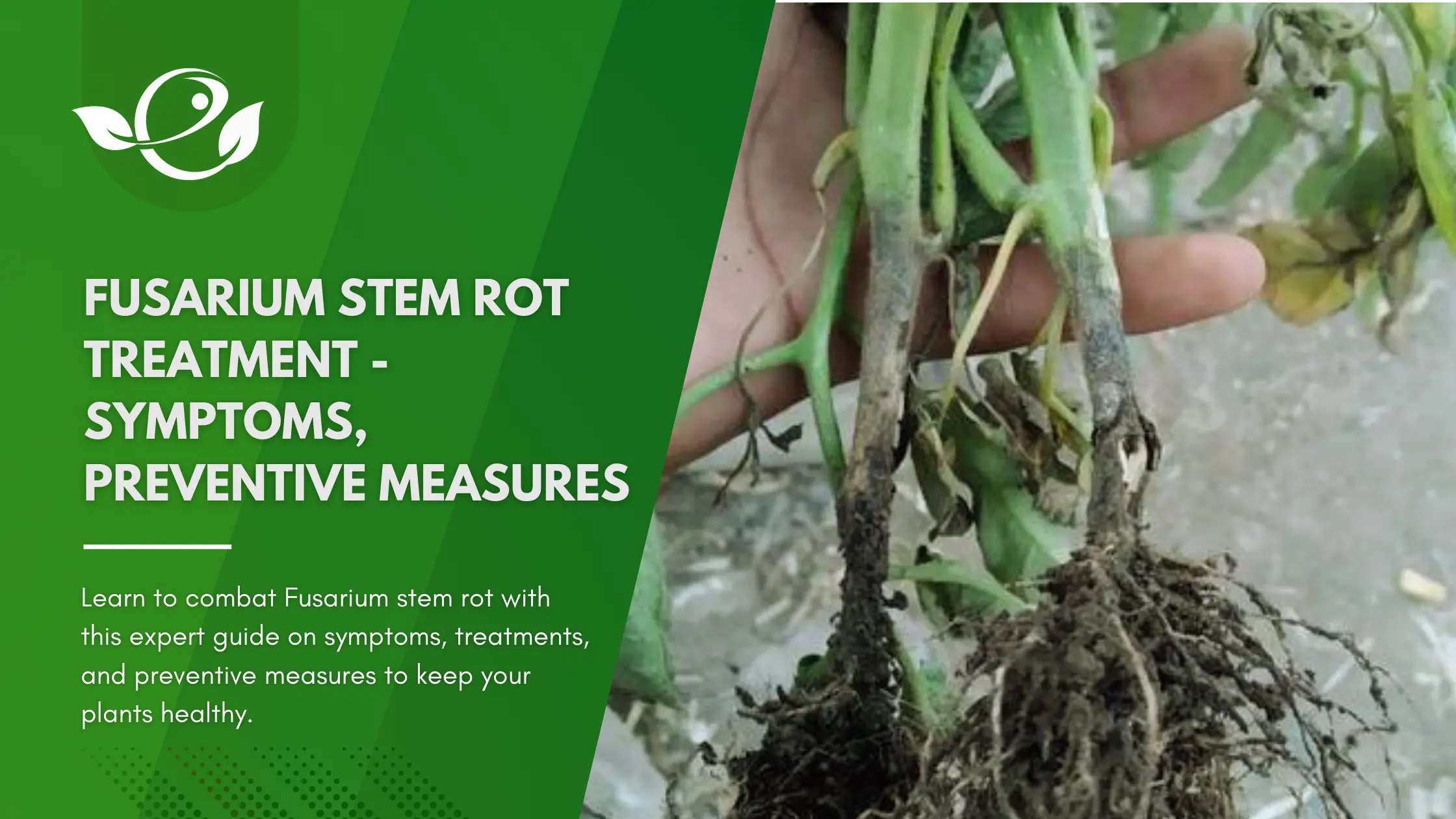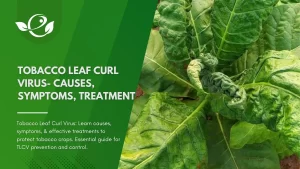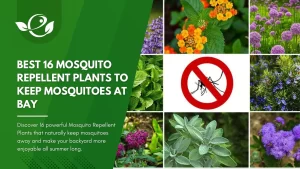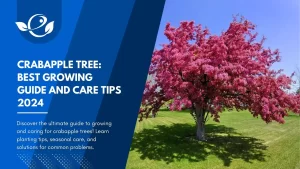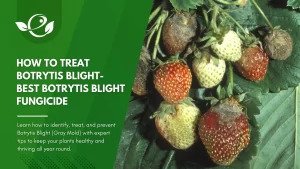Table of Contents
Picture this: You’ve spent months nurturing your plants, talking to them, maybe even singing a song or two (we won’t judge). Suddenly, your once thriving green beauties look like they’ve had a bender at a plant party. Leaves are wilting, stems are streaked with unsightly brown or black marks, and your garden looks more like a crime scene than a peaceful oasis. What’s the culprit? It’s not a sneaky neighbor or mischievous gnomes; it’s something far more sinister: Fusarium stem rot.
Fusarium stem rot is like the unwanted guest at your garden party. It shows up uninvited, causes chaos, and leaves you with a mess to clean up. This pesky disease, caused by the Fusarium fungi, targets a wide variety of plants, turning your green-thumb dreams into a horticultural nightmare. But fear not, fellow plant enthusiasts! We’re here to arm you with the knowledge and tools to kick this fungal freeloader to the curb.
Why should you care about Fusarium stem rot, you ask? Well, imagine saving your garden (and your sanity) from the clutches of this fungal fiend. The purpose of this blog is to transform you into a Fusarium-fighting superhero. We’ll guide you through recognizing the symptoms, exploring treatment options, and implementing preventive measures to keep your plants healthy and happy. By the end of this article, you’ll be ready to tackle Fusarium stem rot head-on, armed with the wisdom of seasoned gardeners and the enthusiasm of a plant parent who refuses to give up.
Ready to dive into the world of Fusarium stem rot and emerge victorious? Let’s get started!
Understanding Fusarium Stem Rot
What is Fusarium Stem Rot?
Fusarium stem rot is a plant disease caused by Fusarium fungi, specifically Fusarium oxysporum and Fusarium solani. These fungi invade plant tissues, leading to decay and rot, primarily affecting the stem and root systems. The disease can be devastating, causing significant yield losses in crops and severe damage to ornamental plants.
- Scientific name: Fusarium solani
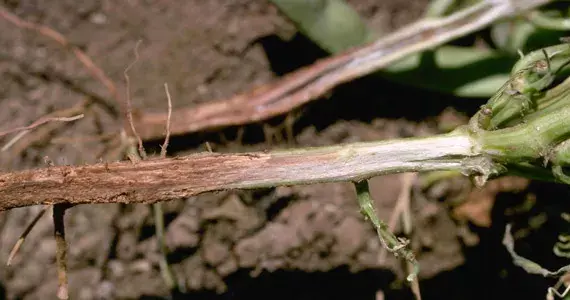
What caused it?
Fusarium solani is a fungus that grows in transport tissue of plants, affecting water and nutrient supply. Plants can be infected directly via their root tips or through wounds in the roots. Once the pathogen has become established in an area, it stays active for several years as it can create overwintering spores. Soil-borne diseases survive in soil and spread through seed, soil, water, seedling, workers, irrigation water and wind (by carrying infected plant debris).
The fungus is a serious disease-causing organism that affects various hosts. If infestation happens at flowering stage, serious yield loss can be expected. Stem cankers restrict the upward flow of water, which causes wilting and eventually the death of plant. Fusarium solani can colonize dead or dying plant tissues and actively ejects spores nightly. Favourable conditions of the fungi are relatively high soil moisture and soil temperature. Poor water drainage or overwatering support the disease spread.
Affected Plants
Fusarium stem rot affects a wide range of plants, including:
- Crops: Tomatoes, brinjal, sweet potato, chilli peppers, cucumbers, melons, and potatoes.
- Ornamentals: Roses, carnations, and other flowering plants.
- Trees and Shrubs: Various species in nurseries and landscapes.
Understanding which plants are susceptible helps in early detection and implementing preventive measures.
Symptoms of Fusarium Stem Rot
- Clearing of veinlets.
- Chlorosis of leaves.
- Browning of vascular system.
- Stunned growth
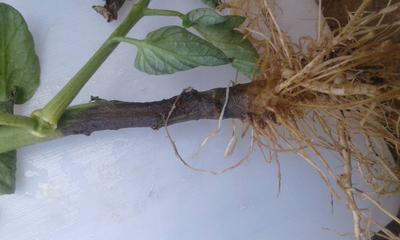
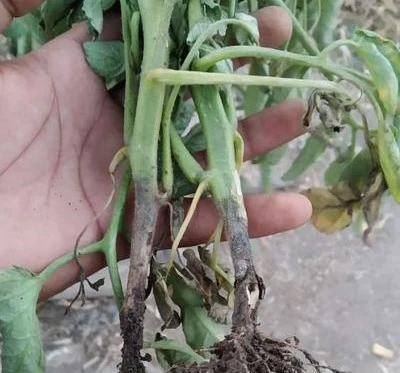
Clearing of veinlets and chlorosis of leaves are the initial disease symptoms. In young plants, symptoms consist of veinlet clearing, following by drooping of petioles. Yellowing is first observed on lower leaves. These leaflets wilt and die eventually, spreading the symptoms to subsequent leaves.
At a later stage, the browning of the vascular system occurs. The lower leaves and later all leaves of the plant will drop off. The plants become stunted and die. Soft, dark brown or black cankers appear on the stem, usually at nodes and wound sites, causing girdling of the stem. The lesions develop light orange-coloured, very small, flask-shaped fruiting structures of the fungus (perithecia). White-cottony fungal growth may form on the plant. The roots, when infected, become dark brown, soft and water soaked. Pepper fruits might develop black, water-soaked lesions beginning at the calyx.
Treatment of Fusarium Stem Rot
Chemical Treatments
Always consider an integrated approach with preventive measures together with biological treatments, if available. Apply soil-based fungicides on contaminated locations if no other measures are effective. Drenching the soil with Copper Oxychloride @ 3g/l of water before sowing/transplanting is also effective. Other products based on Carbendazim, Fipronil, Fluchloralin can also be applied to limit the disease spread.
- Fungicides Effective Against Fusarium Species: Systemic fungicides containing active ingredients like thiophanate-methyl, azoxystrobin, and fludioxonil can control Fusarium infections.
- Application Methods and Timing: Fungicides should be applied as soil drenches, foliar sprays, or seed treatments. Timing is crucial—early applications during initial symptom onset provide the best results.
Biological Controls
Recommendations: We recommend following organic control methods in the early stages of a disease or when the crop is close to harvesting. In more advanced stages of a disease, please follow chemical control measures. Mixing or applying different products at the same time is not recommended.
Several biological control agents, including bacteria and nonpathogenic strains of F. oxysporum that compete with the pathogens, have been used to control Fusarium wilt in some crops. Trichoderma viride @ 1% WP or @ 5% SC can also be used to treat the seeds (10g/kg seed). Other products based on Bacillus subtilis, Pseudomonas fluorescens are also effective. Trichoderma harzianum can be applied to the soil.
- Beneficial Microorganisms: Trichoderma species, Bacillus subtilis, and mycorrhizal fungi can combat Fusarium by outcompeting the pathogen, inducing plant resistance, or producing antifungal compounds.
- Integrating Biological Controls into Treatment Plans: Combining biological controls with cultural practices and chemical treatments can enhance overall disease management.
Cultural Practices
Cultural practices play a vital role in managing Fusarium stem rot by creating unfavorable conditions for the pathogen.
- Proper Irrigation and Drainage Techniques: Avoid waterlogged conditions, as excess moisture promotes Fusarium growth. Implement well-drained soil conditions and appropriate irrigation schedules.
- Crop Rotation and Soil Management: Rotate susceptible crops with non-host plants to reduce Fusarium inoculum in the soil. Improve soil health by incorporating organic matter and maintaining balanced fertility.
Resistant Varieties
Planting resistant varieties is a proactive approach to managing Fusarium stem rot.
- Selecting and Planting Fusarium-Resistant Plant Varieties: Many breeders have developed Fusarium-resistant cultivars for various crops. Consult seed catalogs and agricultural extensions for resistant varieties suitable for your region.
- Benefits and Limitations: While resistant varieties can significantly reduce disease incidence, they may not be completely immune. Combining resistant varieties with other management practices offers the best protection.
Preventive Measures
- Plant only healthy plants from the available resistant varieties, such as Phule Jyoti and Phule Mukta.
- Monitor the plants for symptoms, such as wilting or stem lesions.
- Handpick and remove affected plants carefully.
- Discard them by either placing them in a landfill or burning them far away.
- Keep your equipment and tools clean, particularly when working between different fields.
- Avoid damage to the plants during field work.
- Good crop hygiene and pruning by clean cutting can help control the disease.
- Adjusting the soil pH to 8.5-7.0 and using nitrate rather than ammonium as nitrogen sources can reduce the severity of the disease.
- In greenhouses, use precisely adjusted drip irrigation.
- Avoid use of excessive fertilizer concentration.
- After harvest, remove plant debris and burn them.
- Keep in mind that the rotting can continue in storage.
- Disinfect the seedbeds by covering the area with black plastic foil under direct sunlight for a month.
- Follow crop rotation to reduce levels of fungi in the soil.
Conclusion
Congratulations, dear reader! You’ve made it to the end of our deep dive into the world of Fusarium stem rot. Let’s take a quick victory lap and recap what we’ve learned. Fusarium stem rot is a formidable foe, causing yellowing leaves, wilting, and streaky stems that make your plants look like they’re in a botanical horror movie. But armed with the knowledge of early and advanced symptoms, chemical and biological treatments, and essential cultural practices, you now have a robust arsenal to combat this fungal invader.
Think of your garden as a fortress and Fusarium as the sneaky invader trying to breach your defenses. The best strategy? Proactive management! Early detection is your first line of defense, so keep those eyes peeled for any signs of trouble. Regular inspections, combined with good sanitation practices and environmental control, will keep your plants in tip-top shape. Remember, a healthy plant is a happy plant, and happy plants are less likely to fall victim to Fusarium stem rot.
The battle against Fusarium stem rot doesn’t end here. Stay engaged and informed by seeking out additional resources, connecting with fellow gardeners, and keeping up with the latest research. The world of plant health is ever-evolving, and staying ahead of the curve will ensure you remain the hero of your garden.
Happy gardening, and may your plants be ever green and your garden ever bountiful! 🌱🌸🌿
